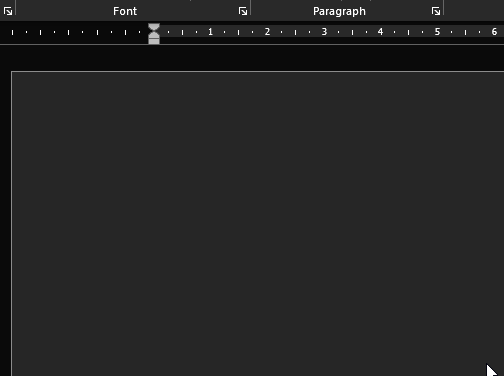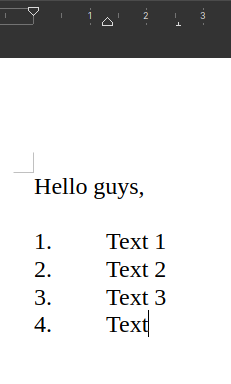In Micro$oft Word (.docx, windows 10 22H2):-

I can click and drag the “1.” to the left, so that it is just under the “T” in “This is some text”. I want to do the same in Writer.

In Micro$oft Word (.docx, windows 10 22H2):-

I can click and drag the “1.” to the left, so that it is just under the “T” in “This is some text”. I want to do the same in Writer.
I can’t identify the user interface you’re using (or perhaps it is another application). So please, edit your question to make it more explicit. Mention OS name, exact LO version and save format.
How familiar are you with styles, notably list styles?
Your animated screenshot shows your list item is created contextually (AutoCorrect option in Writer). This is not the best way to customise lists.
What is your precise requirement? Where do you want your number located?
In Writer parlance, margins is the no-print area around the usable part of the page). Paragraphs can have optional indents which temporarily add to the margins.
How do you want the list item text indented relative to the margins/number?
All these parameters are “comfortably” controlled by a list style.
Even if you are not using styles, and want to do the “I want to do it “simple” way, no matter if my document becomes an unmanageable mess”: there is something on your screencast, that is also present in Writer, that is intended to control things, and is visually obvious - unlike the awful “you may drag a part of text, and suddenly, that would change offsets / indents, unlike dragging other parts of the text” bright example of bad UX. The correct controls are the thumbs on the ruler (in this case, you would drag-adjust the top thumb).
If I drag adjust the top thumb, only the number on the active line moves.
 ====>
====>
SCREENSHOT TAKEN IN LIBREOFFICE WRITER 25.2 FLATPAK
Then select all the lines you need, how’s that?
That works, but there are now huge spaces.

And if try to move the second slider, the first one moves with it.
Are you trying to learn using the program here? There is extensive documentation. Yes, you are correct; and if you need to move two together, move just the second one.
Well, I guess I have to learn a lot of stuff.
With MS-Word I’ve never cared about these things before. I’ve written entire books (as a hobby) from pre-made templates mostly, so yeah, it’s reasonable for you to get offended.
Or rather, the learning curve back then was new, and you didn’t think “I already know how to do this and that, why is this so different?”. The past effort is neglected; the new equal effort is considered too much 
Then you can drag that to desired position first. Drag the first slider again to readjust the numbering position.
The Office suites from MS and Libre are developed from different underlying strategies.
With this difference in mind …
For myself, I alternate between the suites at work, but on strictly separate documents. My personal chosen platform for document production is LibreOffice. For documents where collaboration is expected, as well as for other collaborative functionality, I use the employer’s chosen platform, M365. As long as you are aware of the implications, the suites coexist fairly peacefully.
Yes, I really want to learn LibreOffice. Especially because it’s cross-platform and so actively developed. I am trying to completely cut off proprietary stuff from my life. I don’t need the power of Photoshop or Illustrator, I’m not a graphic designer. GIMP has a few hiccups, but it gets the job done. MS-Word is that one thing that’s hard to un-learn, because I’ve been using it since my childhood hehe 
But I’ll try my best and learn it from YT Tutorials, or using AI to ask basic stuff. It was immature of me to make this thread, I kind of accept that now…
I then recommend the excellent Bruce Byfield’s Designing with LO available in the documentation page. It will get you acquainted with LO philosophy. After, read from the same link the guide for the applications you need (Writer, Calc, …) to learn where the controls for the features are “hidden”.
Thank you, this is an amazing booklet! More intuitive than the official documentation, atleast 
Wasn’t able to find this book in the documentation page, but a google search found it from designingwithlibreoffice.com
You must scroll downward quite a bit.